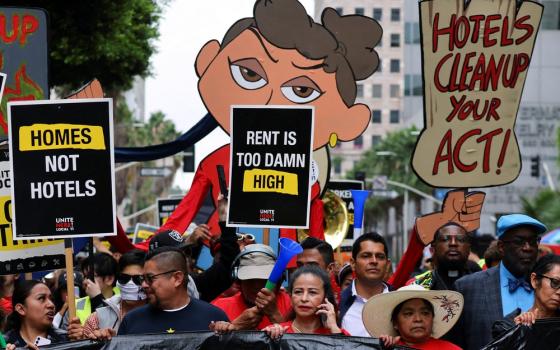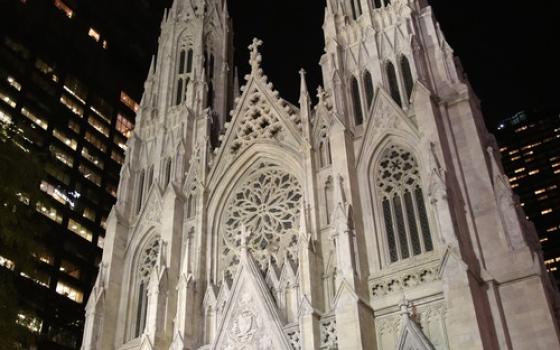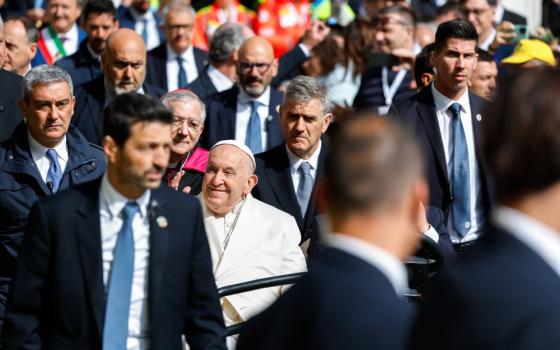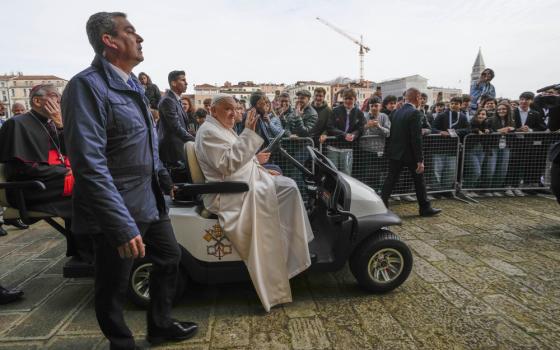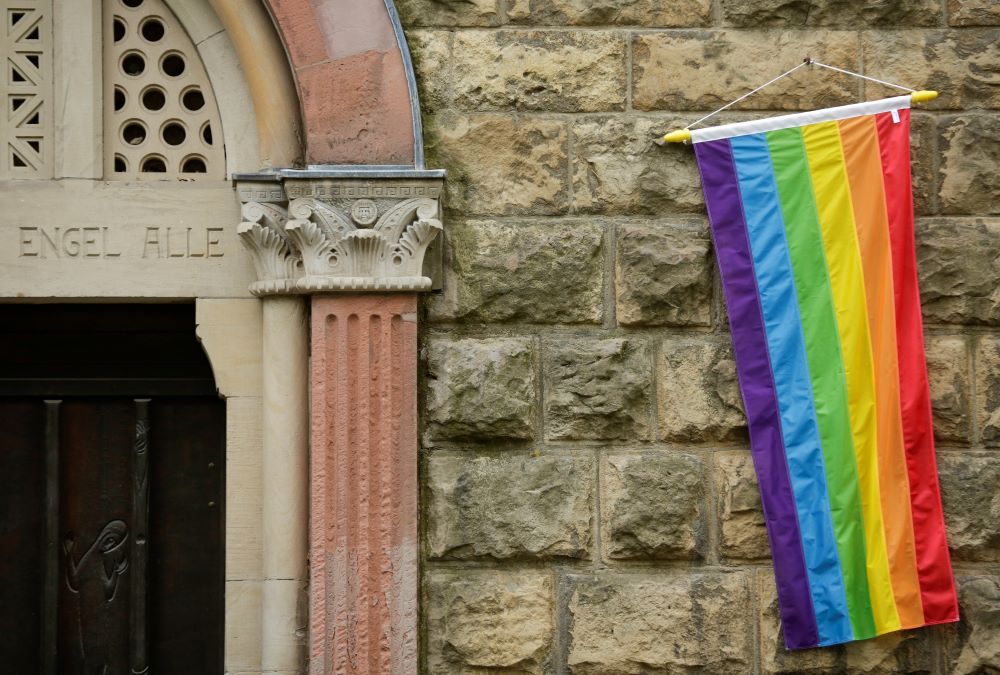
A rainbow flag is seen on the wall of a Catholic church in Cologne, Germany, May 10, 2021. (OSV News/Reuters/Thilo Schmuelgen)
It's hard to know what to do with Dignitas Infinita, because it doesn't fit our neat, almost cliché narratives about Pope Francis or his leadership style. In particular, the document has drawn ire for its condemnation of "gender theory" and sex change treatments — which sound out of place for a pope who has made pastoral attention to LGBTQ+ people a priority of his episcopate.
In so many ways, Francis' approach has been revolutionary and has brought LGBTQ+ Catholics like myself moments that we never thought imaginable for a pope: He has developed an ongoing relationship with Rome's transgender community, built bridges with previously ostracized leaders in LGBTQ+ Catholic ministry, opened the door for blessing same-sex couples and condemned the criminalization of homosexuality. For many queer Catholics, myself included, the church felt like it was at a turning point, in large part due to the efforts of a pope committed to listening.
We have come far, I tell myself.
After reading Dignitas Infinita, I'm not so sure anymore.
The document's actual stance on transgender rights is not remotely surprising. It is a folly to expect immediate doctrinal change from this church — and the vast majority of us recognize as much. What is surprising, however, is just how little actual listening appears to have gone into writing its sections on "Gender Theory" and "Sex Change."
A quick Control+F search illustrates this point well: Dignitas Infinita uses the term "gender theory" seven times, but not once does it refer to "transgender" people. To this end, it is a syntactically strange document, one that bends over backward trying to ascribe "gender theory" with a mystical agency of its own: "gender theory" prescribes; "gender theory" intends; "gender theory" advances.
This document is a painful missed opportunity for the church to signal its willingness for dialogue. It didn't have to be this way.
It seems that "gender theory" here is a code-word for talking about transgender people and their allies. This begs the question: Is the Vatican afraid of trans people and therefore takes pains to erase any direct mention of them from a document about trans issues? Why does it feel the need to hide behind "gender theory"? More concretely, what might the document look like if it wrestled, head-on, with the "infinite dignity" of transgender people, for whom "sex change" can be lifesaving?
I'm not the only one who feels an intense whiplash here — wasn’t the whole point that Pope Francis was trying a new, synodal approach to LGBTQ+ encounter? Wasn't he all about listening?
On further reflection, I think I understand what's going on here. It seems obvious to me that His Holiness cares deeply about finding a new approach to LGBTQ+ people beyond the doctrinaire and uncompassionate stance which has often dictated the Vatican's treatment of us. The pope genuinely wants to hear the voices of queer and trans Catholics.
The difficulty, however, is that there's a big difference between hearing and listening. Too often, the new "pastoral approaches" to LGBTQ+ people are one-way streets, and you can see this in how the media talks about them. When Pope Francis meets with transgender people, it is the radical kindness of a loving leader. He is brave. But the reverse is almost never pondered: What of the bravery and witness of a trans person who looks a pope in the eye? Who is the actor here, and who is acted upon? Who is leading, and who is learning?
What did the church learn from this new "pastoral approach"?
Advertisement
In an attempt find the silver lining, some point out that the new declaration reiterates "that every person, regardless of sexual orientation, ought to be respected in his or her dignity and treated with consideration, while 'every sign of unjust discrimination' is to be carefully avoided, particularly any form of aggression and violence." Put aside the fact that the church still engages in "unjust discrimination" against the LGBTQ+ community. For a document that took five years to write, was one reference to a line in the Catechism about "sexual orientation" (not at issue here) all the Vatican's Dicastery for the Doctrine of the Faith could come up with? Does this demonstrate meaningful attentiveness to the "infinite dignity" of transgender people? When our "pastoral encounters" do not move us at all, they can hardly be called "pastoral encounters."
They are not examples of synodality. They are examples of clericalism.
Obviously, there is more at play than meets the naked eye. Modeling a new approach for dialogue with the LGBTQ+ community will take time, and Pope Francis is subject to a whirlwind of pressures that come with the terrain of shepherding a global church. We saw these pressures on full display in the wake of Fiducia supplicans. But we should not see this as a zero-sum game, where an advance for one group of LGBTQ+ people means that another must wait. As a gay Catholic, I don't feel comfortable with different members of my community being treated as bargaining chips — much less so in a document about the "infinite dignity" of all our siblings in Christ. Even if it takes time, there is always a way to move the ball forward, even just a few inches. This document is a painful missed opportunity for the church to signal its willingness for dialogue. It didn't have to be this way.
Again, I do not anticipate that the church will change its stance on LGBTQ+ issues overnight. Nevertheless, a synodal church that wants to encounter LGBTQ+ people must do so from a stance of mutual vulnerability. It needs to be willing to learn. This document does not demonstrate that willingness, and therefore runs the risk of alienating its conversation partners. Queer and trans Catholics do not deserve to be strung along by one-sided encounters. They deserved to be listened to.
I'm reminded of a funny linguistic coincidence from the Book of John. Questioning Jesus, Pontius Pilate asks "What is truth?" In Latin, this reads "Quid est veritas?" Some medieval commentators noticed that there's an unintended anagram here. "Quid est veritas" rearranges to "est vir qui adest," or in English, "It is the man in front of you." Pilate's question has answered itself.
What is truth? It is the man in front of you.
For Pilate, this is of course Jesus. But we need not stop there. Everyone indeed has "infinite dignity." This includes trans people, who have so much to teach our wandering little church. They are the truth, standing in front of us. Do we have the courage to learn that truth by listening, or will we be like those who "look but do not see and hear but do not listen"?




